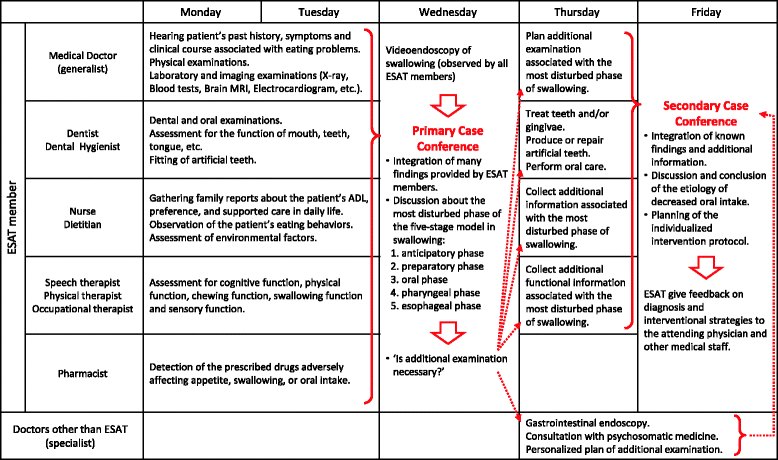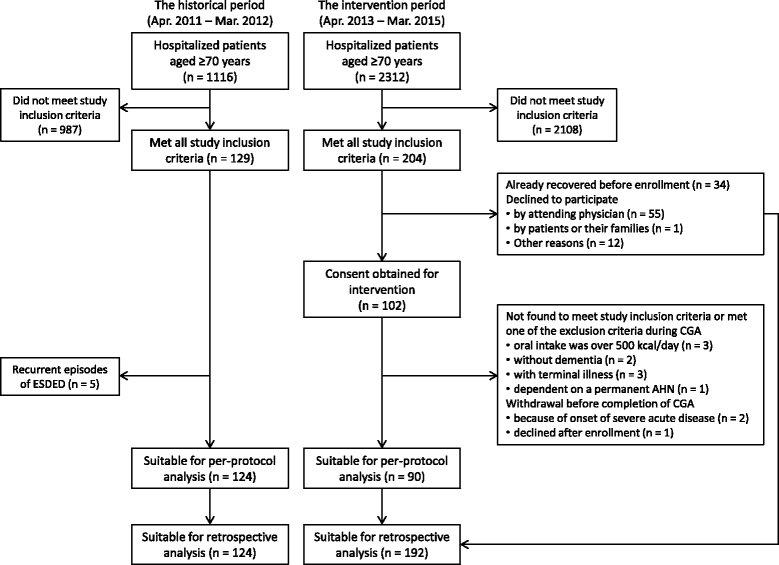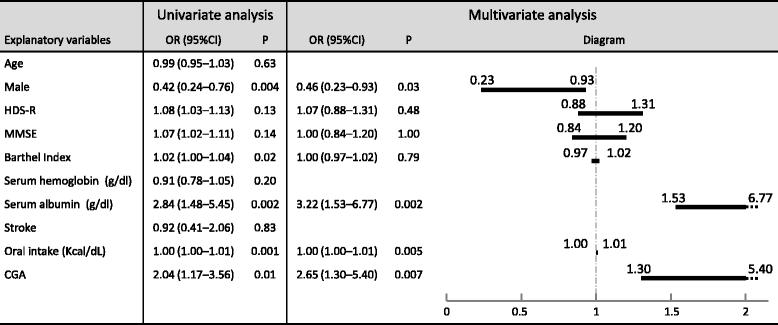A comprehensive intervention following the clinical pathway of eating and swallowing disorder in the elderly with dementia: historically controlled study
- PMID: 28705163
- PMCID: PMC5512987
- DOI: 10.1186/s12877-017-0531-3
A comprehensive intervention following the clinical pathway of eating and swallowing disorder in the elderly with dementia: historically controlled study
Abstract
Background: Eating problems in patients with advanced dementia are strongly associated with their deteriorating survival. Food and drink intake in people with dementia may be supported by specific interventions, but the effectiveness of such interventions is backed by almost no evidence. However, comprehensive geriatric assessment (CGA) might potentially clarify the etiology of decreased oral intake in people with dementia; thus improving their clinical outcomes.
Methods: This study was a single-arm, non-randomized trial that included historically controlled patients for comparison. We defined elderly patients with both severely decreased oral intake depending on artificial hydration and/or nutrition (AHN) and dementia as "Eating and Swallowing Disorder of the Elderly with Dementia (ESDED)". In the intervention group, participants received CGA through the original clinical pathway with multidisciplinary interventions. This was followed by individualized therapeutic interventions according to assessment of the etiology of their eating problems.
Results: During the intervention period (between 1st April 2013 and 31st March 2015), 102 cases of ESDED were enrolled in the study and 90 patients had completed receiving CGA. Conversely, 124 ESDED patient controls were selected from the same hospital enrolled during the historical period (between 1st April 2011 and 31st March 2012). Most participants in both groups were bedridden with severe cognitive impairment. For the intervention group, an average of 4.3 interventional strategies was recommended per participant after CGA. Serological tests, diagnostic imaging and other diagnostic examinations were much more frequently performed in the intervention group. Recovery rate from ESDED in the intervention group was significantly higher than that in the historical group (51% v.s. 34%, respectively, P = 0.02). The 1-year AHN-free survival in the intervention group was significantly higher than that in the historical group (28% v.s. 15%, respectively, P = 0.01). No significant difference between the two groups was found for 1-year overall survival (37% v.s. 28%, respectively, P = 0.08).
Conclusions: Use of CGA with multidisciplinary interventions could improve the functional status of eating and allow elderly patients with severe eating problems and dementia to survive independently without the need for AHN.
Trial registration: ISRCTN57646445 , this trial was retrospectively registered on 8th December 2015.
Keywords: Clinical pathway; Comprehensive geriatric assessment; Decreased oral intake; Dementia; Elderly; Multidisciplinary team approach.
Conflict of interest statement
Authors’ information
Not applicable.
Ethics approval and consent to participate
Ethics approval was obtained from The Institutional Review Board of Nanto Municipal Hospital on 21st March 2013; reference number 664.
Written consent to partake in the study was obtained from all participants. If participants suffered from advanced dementia, informed consent was obtained from their proxies.
Consent for publication
Not applicable.
Competing interests
All authors declare that they have no competing interests.
Publisher’s Note
Springer Nature remains neutral with regard to jurisdictional claims in published maps and institutional affiliations.
Figures




References
-
- Wakabayashi H. Presbyphagia and sarcopenic dysphagia: association between aging, sarcopenia, and deglutition disorders. J Frailty Aging. 2014;3:97–103. - PubMed
Publication types
MeSH terms
Associated data
LinkOut - more resources
Full Text Sources
Other Literature Sources
Medical
Research Materials
Miscellaneous

